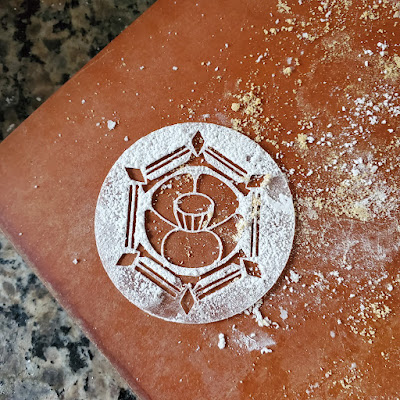Sakura Mochi Variations 1
Sakura mochi is typically divided into Kanto style and Kansai style. There are also other variations depending on the particular wagashi sweets shop.
Kanto style may sometimes be called Choumeiji sakura mochi named after a temple near the shop that first sold such style of sakura mochi. Choumeiji sakura mochi has a distinct appearance of a thin pink mochi crepe rolled around a log of red bean paste and covered with a pickled sakura leaf.
Kansai style may also be called Doumyouji sakura mochi named after the temple that first invented the style of rice flour that is used for this version of sakura mochi. The doumyouji mochi has a pink, rough grainy texture of mochi that contains red bean paste inside and covered with a pickled cherry blossom leaf.
My conclusion is that a sakura mochi should have these things:
- Pink mochi exterior
- Pickled sakura leaf covering
- Some sort of bean paste filling
Choumeiji Sakura Mochi
- Dissolve shiratama-ko with 1 tbsp of water, scraping the bowl with a rubber spatula to break the clumps.
- Add milk (or water) in 4 additions. Each time dissolving as much shiratama-ko as possible before the next addition.
- Add food coloring before the final addition of milk or water.
- Sift in cake flour and combine well.
- Let stand for 30 minutes, then stir to combine again.
- Soak pickled sakura leaves in a bowl of fresh water for 10 minutes to desalinate. Pat dry with paper towel.
- Heat a non-stick pan on very, very low heat.
- Brush some oil onto the pan and wipe off excess.
- Pour about 1 tbsp of batter onto the pan and use the bottom of a spoon to help spread the batter thinly and into an oval shape.
- You'll see the batter change colors slightly, this should be the cue that it can be peeled off the pan and flip over.
- Grill the other side for a few seconds.
- Store covered in plastic wrap while you make the rest of the crepes to prevent drying.
- Divide red bean paste into 30g portions and shape into logs (don't think, just do LOL)
- Drape the crepe over the red bean paste and roll it, user the prettier side.
- Wrap the roll with a sakura leaf with the underside (veins) facing out.
Fukusa Tsutsumi Sakura Mochi
- Start with mixing a tiny amount of water with the shiratama-ko and dissolve the clumps as much as possible. Add more water a tablespoon at a time when its saturated to continue dissolving.
- Add sugar, add 75 mL (1/4 cup) water, dissolve.
- Sift in flour, add another 75 mL water, mix.
- Add food coloring.
- Add the remaining water, mix.
- Let stand for 10 minutes, then mix again.
- In a tiny heat-safe bowl, put in 30 mL (2 tbsp) of batter and cover with plastic wrap.
- Microwave for 30 second on 600W power
- Dust your work surface with potato starch
- Dust the top of the dough in your little bowl before digging it out onto the work surface with a rubber spatula
- Dust the rest of the surface of the dough with potato starch
- With a rolling pin, start rolling the dough out into a thin circular crepe. You can roll in a circular an outward motion to create the shape (think dumping skins if you've ever made them)
- Store under plastic wrap and make and another crepe using Steps 7-12.
- Mix (A) and (B) together in a small bowl, set aside.
- Divide your white bean paste into 25 g portions.
- Roll the bean paste into a ball and flatten slightly.
- Toss into the bowl from Step 14 to coat with kinako powder.

- Place the coated bean paste filling in the center of the crepe
- Bring the top and bottom edges of the crepe to the center, wet the overlapping area an gently press to seal.
- Bring the left and right edges of the crepe to the center, wet the overlapping area and gently press to seal. Dust with potato starch if there are wet spots.
- Soak cherry blossom leaves in fresh water to desalinate for 10 minutes. Pat dry with paper towel.
- Place mochi on a cherry blossom leaf.
- You can dust with icing sugar just before serving.
Afterthought
- It was difficult to spread the batter as it cooked very quickly on even "min" setting, so it ended up being a bit thick
- Produced a smooth, shiny, but tacky side and a dry but rough side
- Crepe overall tasted dry and flavorless, probably needed more sugar
- Crepe felt rubbery and has no elasticity LOL
- I can control how thin I wanted it
- Is not tacky, both sides can be presentable/usable
- Crepe is soft and has elasticity. Easy to manipulate when wrapping.
- Texture is also soft and mochi-mochi feel when eating






glad you're still alive! I still enjoy a browse through your recipes! If you're active on a different platform would love to know!
ReplyDelete